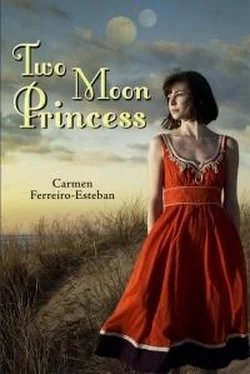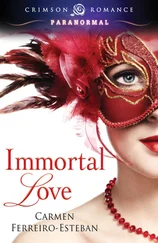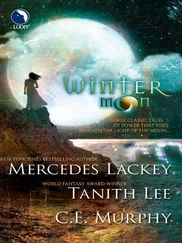“The Spaniards knew how to build aqueducts to bring water down from the mountains,” Tío explained. “This was once a rich valley. They grew crops of olives and corn, peppers and almonds.”
As Tío talked, I heard Don Alfonso’s voice in my mind. The Arabs who overcame King Roderic were said to possess the knowledge of converting a desert into a garden. And nothing would please my brother more than to give water to our desert lands .
I shrugged the memory away. “Is Spain dry,Tío?” I asked, as that would explain their expertise in transporting water from place to place.
Tío nodded. “The southern part is. And remind me when we get back to Davis to find you some books about Spain. You’re supposed to be from there.”
“But not from the south, okay? I don’t know anything about deserts.”
Tío smiled. “All right, then. We’ll say you are from Asturias. I did the research for my dissertation there, searching for remains from the time when your ancestors left Spain.”
“Did you find any?”
Tío was so lost in his own thoughts, I had to repeat my question.
“Find what?”
“Remains from the time of my ancestors.”
“Yes, I did. But no proof of your ancestors crossing to another world. Of course.”
He did not say more and I did not press him. But I knew there was something else he was not telling me. I wondered what he had found there that still gave him such a faraway look after all these years.
“What happened?” I asked Tío later as we sat around the fire. “Why was the mission destroyed?” We had erected the tents already, farther down the hill from where the mission once stood, under the protection of an ugly modern compound my uncle explained held restrooms and showers for summer field courses held there.
Tío sighed. “It is a long story. Do you really want to hear it?”
I nodded, and Tío smiled at me in a sad kind of way. Eyes deep in the fire, he started talking.
“After your ancestors left Spain, the Spaniards wrested their country back from under Arab control. It was a long process that lasted over seven hundred years. And when they were done, well, I guess they were used to the conquest, so they crossed the ocean and came to America to continue.
“First they conquered the Aztec empire south of here, in the country that is now called Mexico. Then they traveled north and west and eventually came to California. The first Spaniards to arrive here were the padres, religious people who didn’t want to conquer, but to convert the natives to their own religion.
“The Native Americans, at least in this particular area, were peaceful. They didn’t fight the foreign people. Some even volunteered to help the Spaniards build the missions and, when they were finished, came to live in them as well.
“But the Native Americans were not happy. They were not used to living in closed spaces. They hated the bells tolling throughout the day, telling them when to rise, when to pray, when to eat, and reminding them of their lost freedom.
“Then things got worse. The Spaniards were defeated by the new elite that had evolved in Mexico, and the new government stopped paying the soldiers garrisoned in the missions. The Native Americans had to feed the soldiers who were supposed to protect them from a danger they couldn’t fathom. So eventually, they rebelled against the soldiers and burned the missions down.”
“But not Santa Inés?”
“They burned Santa Inés, too. They burned the barracks that housed the soldiers. But when the church caught fire, they put down their weapons and helped the padres save it. Then they disappeared into the wild. They never lived in the mission again.”
I stood still, gazing into the flames.
“Why did the Spaniards come in the first place,Tío?”
Tío bent over the fire and grabbed a branch, stirring sparks into the night air. “Some came for gold,” he said, “some for glory. But I think the padres, the men who founded the missions, were not interested in gold or glory. They were “holy fools.” They really believed they were saving their souls by converting the Native Americans to their religion.”
A coyote cried in the distance, and I looked up. But I couldn’t see it. The night was dark; the moon was not to rise until midnight.
I bent closer to Tío. “You think the Spaniards shouldn’t have come, don’t you,Tío?”
Tío looked at me and smiled. “On the contrary. If there had been no missions, I wouldn’t have a job, would I?”
We remained in silence for a while, watching the flames dance in the wind. And then, when the fire died, we went inside our tents. And for the first time ever, I slept in the open, only a thin canvas separating me from the stars.
The next day, Tío wanted to visit another mission. Fearing another disappointing bunch of ruins, I demurred. But La Purísima, Tío reassured me, was fully restored, by which he meant it had been rebuilt after its destruction.
“I promise you’ll like it,” Tío said.
And he was right. La Purísima had been constructed by a stream against a red-sand hillside covered with trees and, like Santa Inés, was unbelievably beautiful in its simplicity.
But Tío had not told me everything. He had failed to mention the fact that the mission was inhabited. And not only by tourists like us, wearing jeans or shorts and bright shirts, but by men in the brown robes of the padres and women wearing white loose shirts and long skirts with handkerchiefs over their heads. I could also see men dressed in peasant clothes, working in the fields or attending to the cattle and sheep grazing in the enclosed pastures behind the whitewashed buildings of the mission.
“They are not for real,” Tío said as he led me to the main door that opened to the cloister where a small crowd had gathered.
“What do you mean they are not for real?”
“I mean they are people pretending to live as if they were at the end of the 1800s, when this mission was first established.”
“Why?”
“You’ll see,” he said. He signed me for a tour. But he excused himself to go speak with the director of the mission.
And so I found myself following a cheerful middle-aged woman, who was split in two by a red scarf around her waist, through different rooms where people in similar attire performed different tasks, such as grinding corn on flat stones for tortillas, making candles and soap, or spinning wool and weaving the yarn into colorful blankets. And all these chores, our guide explained, closely mimicked life as it had been when the Spanish padres had lived there.
Everyone in my group seemed to enjoy the visit, but for reasons I could not understand, I found it unbearably sad, and when the guide led us out of the church, I fell behind. I strolled along the fiery red wall that started to the right of the church until I found a wooden double door that opened into the old mission graveyard.
I walked about the tombs, reading the windswept gravestones, and again and again I found the same year inscribed on them.
“Did they die when the Indians attacked the mission?” I asked Tío when he finally found me.
Tío shook his head. “No. Yesterday I didn’t tell you the whole story. These people didn’t die by the sword. They were killed by one of the diseases the Spaniards brought with them. The Spaniards had become resistant to various illnesses over the years. But the natives, having never been exposed to them, died by the thousands. Millions, if you consider the whole continent.”
Unable to grasp the enormity of what Tío was saying, I turned my eyes to the stone sitting at my feet: 1818–1820 , I read. The girl or boy lying here had been only two years old. And for a moment, the red walls I had found soothing before seemed painted in blood. I felt sick.
Читать дальше












